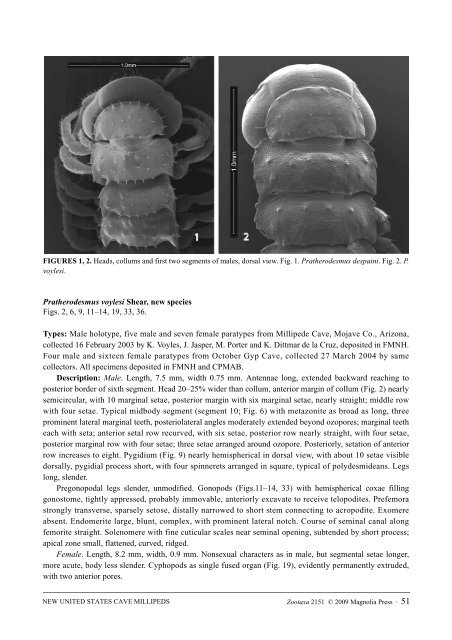Full article - Magnolia Press
Full article - Magnolia Press
Full article - Magnolia Press
You also want an ePaper? Increase the reach of your titles
YUMPU automatically turns print PDFs into web optimized ePapers that Google loves.
FIGURES 1, 2. Heads, collums and first two segments of males, dorsal view. Fig. 1. Pratherodesmus despaini. Fig. 2. P.<br />
voylesi.<br />
Pratherodesmus voylesi Shear, new species<br />
Figs. 2, 6, 9, 11–14, 19, 33, 36.<br />
Types: Male holotype, five male and seven female paratypes from Millipede Cave, Mojave Co., Arizona,<br />
collected 16 February 2003 by K. Voyles, J. Jasper, M. Porter and K. Dittmar de la Cruz, deposited in FMNH.<br />
Four male and sixteen female paratypes from October Gyp Cave, collected 27 March 2004 by same<br />
collectors. All specimens deposited in FMNH and CPMAB.<br />
Description: Male. Length, 7.5 mm, width 0.75 mm. Antennae long, extended backward reaching to<br />
posterior border of sixth segment. Head 20–25% wider than collum, anterior margin of collum (Fig. 2) nearly<br />
semicircular, with 10 marginal setae, posterior margin with six marginal setae, nearly straight; middle row<br />
with four setae. Typical midbody segment (segment 10; Fig. 6) with metazonite as broad as long, three<br />
prominent lateral marginal teeth, posteriolateral angles moderately extended beyond ozopores; marginal teeth<br />
each with seta; anterior setal row recurved, with six setae, posterior row nearly straight, with four setae,<br />
posterior marginal row with four setae; three setae arranged around ozopore. Posteriorly, setation of anterior<br />
row increases to eight. Pygidium (Fig. 9) nearly hemispherical in dorsal view, with about 10 setae visible<br />
dorsally, pygidial process short, with four spinnerets arranged in square, typical of polydesmideans. Legs<br />
long, slender.<br />
Pregonopodal legs slender, unmodified. Gonopods (Figs.11–14, 33) with hemispherical coxae filling<br />
gonostome, tightly appressed, probably immovable, anteriorly excavate to receive telopodites. Prefemora<br />
strongly transverse, sparsely setose, distally narrowed to short stem connecting to acropodite. Exomere<br />
absent. Endomerite large, blunt, complex, with prominent lateral notch. Course of seminal canal along<br />
femorite straight. Solenomere with fine cuticular scales near seminal opening, subtended by short process;<br />
apical zone small, flattened, curved, ridged.<br />
Female. Length, 8.2 mm, width, 0.9 mm. Nonsexual characters as in male, but segmental setae longer,<br />
more acute, body less slender. Cyphopods as single fused organ (Fig. 19), evidently permanently extruded,<br />
with two anterior pores.<br />
NEW UNITED STATES CAVE MILLIPEDS<br />
Zootaxa 2151 © 2009 <strong>Magnolia</strong> <strong>Press</strong> · 51
















